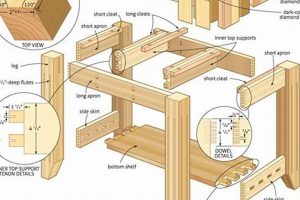Activities involving the use of wood and simple tools designed for young children are educational and engaging. These activities typically utilize soft wood, child-safe tools like small hammers and screwdrivers, and pre-cut pieces of wood to facilitate safe and successful completion. Examples include building birdhouses, creating simple wooden toys, or assembling decorative picture frames. The scope of these projects must align with the developmental capabilities of the age group to ensure safety and foster a sense of accomplishment.
Participation in these constructive tasks fosters the development of fine motor skills, hand-eye coordination, and problem-solving abilities in young learners. Historically, hands-on activities have been recognized as critical for cognitive development, allowing children to explore concepts of spatial reasoning, structural integrity, and tool usage in a tangible way. The benefits extend beyond skill acquisition, contributing to improved self-esteem and a sense of creative agency as children see their ideas materialize.
This article will explore various facets of introducing constructive wooden activities to early childhood education, including considerations for safety protocols, appropriate tool selection, project ideas tailored to specific skill levels, and the integration of these activities into a broader curriculum designed to promote comprehensive development.
Guidance for Early Childhood Wood Construction Activities
The following guidance provides essential considerations for implementing constructive wooden activities with preschool-aged children. Adherence to these recommendations promotes safety, maximizes educational benefits, and ensures a positive experience.
Tip 1: Tool Selection: Employ appropriately sized tools designed specifically for small hands and limited strength. Small hammers with rubber or plastic heads and screwdrivers with large, easy-to-grip handles are recommended. Regular inspection of tools ensures they remain in good working order and free from defects.
Tip 2: Material Selection: Opt for soft woods like pine or balsa, which are easier for young children to manipulate and nail. Ensure that all wood is free of splinters, knots, and sharp edges. Consider pre-cutting the wood to reduce complexity and potential hazards.
Tip 3: Workspace Preparation: Establish a dedicated workspace that is well-lit, ventilated, and free from distractions. Cover the work surface with a protective material to prevent damage. Clearly define boundaries to maintain order and prevent children from wandering into hazardous areas.
Tip 4: Supervision Ratio: Maintain a low adult-to-child ratio to provide close supervision and individualized assistance. This allows for immediate intervention if a child is struggling or using a tool improperly. Demonstrating techniques before each activity is necessary.
Tip 5: Safety Equipment: Implement the use of safety goggles to protect eyes from flying debris. While gloves may hinder dexterity, consider them if children have sensitive skin. A first-aid kit should be readily accessible and personnel trained in basic first aid should be present.
Tip 6: Project Complexity: Begin with simple projects that require minimal steps and limited tool usage. Gradually increase the complexity as children gain confidence and proficiency. Focus on fostering a sense of accomplishment rather than striving for perfection.
Tip 7: Skill-Building Approach: Break down complex tasks into smaller, manageable steps. Teach children how to properly hold tools, hammer nails straight, and turn screws. Provide clear and concise instructions, using visual aids as needed.
The implementation of these constructive wooden activities offers significant advantages, including enhanced fine motor skills, spatial reasoning, and problem-solving capabilities. Prioritizing safety and providing appropriate guidance ensures a rewarding and developmentally enriching experience.
The subsequent sections will delve into specific project ideas suitable for preschool-aged children, focusing on age-appropriateness and educational value.
1. Safety First
In the context of constructive wood activities for preschool children, “Safety First” is not merely a guideline but a foundational principle that dictates every aspect of project design, implementation, and supervision. Prioritizing safety mitigates potential risks and ensures a positive and enriching experience for young participants.
- Adult Supervision and Ratios
Close and constant adult supervision is paramount. A low adult-to-child ratio allows for vigilant monitoring of tool usage, behavior, and project progression. It ensures that educators can promptly intervene if a child is struggling, misusing a tool, or exhibiting unsafe behavior. This also allows for individual instruction and demonstration of proper techniques.
- Protective Gear and Equipment
The implementation of appropriate protective gear is essential. Safety goggles are critical to protect eyes from flying debris, such as wood shavings or splinters. While gloves may impede dexterity, they should be considered if children have sensitive skin or allergies to wood. The work area should be equipped with a readily accessible first-aid kit, and personnel trained in its use should be present during all activities.
- Tool Selection and Maintenance
Careful selection of tools designed specifically for small hands and limited strength is a crucial safety consideration. This includes small hammers with rubber or plastic heads and screwdrivers with large, easy-to-grip handles. Regular inspection and maintenance of tools are necessary to ensure they remain in good working order and free from defects. Damaged or malfunctioning tools should be immediately removed from use.
- Material Selection and Preparation
The selection of appropriate wood materials is intrinsically linked to safety. Softwoods, like pine or balsa, are easier for young children to manipulate and nail. All wood should be carefully inspected for splinters, knots, and sharp edges, which must be removed or sanded smooth prior to use. Pre-cutting wood to reduce complexity and potential hazards associated with sawing is also a recommended practice.
These facets of “Safety First” are not isolated considerations but rather interconnected elements of a comprehensive safety protocol. Their diligent implementation is crucial for ensuring that constructive wood activities for preschool children are both developmentally enriching and inherently safe, minimizing the risk of injury and fostering a positive learning environment.
2. Tool Appropriateness
The concept of “Tool Appropriateness” is fundamental to the successful and safe execution of constructive wooden activities for preschool-aged children. It recognizes that tools designed for adult use are often unsuitable and potentially hazardous for young learners due to differences in size, strength, and motor skills. The selection of tools must align with the developmental capabilities of the children involved.
- Size and Ergonomics
Tools must be appropriately sized for small hands to ensure a comfortable and secure grip. Oversized tools can be difficult to control, increasing the risk of accidents. Ergonomic design considerations, such as large handles and non-slip surfaces, further enhance control and reduce strain on young hands. For example, a small, lightweight hammer with a rubber grip is preferable to a full-sized metal hammer.
- Weight and Balance
The weight and balance of a tool significantly impact a child’s ability to use it safely and effectively. Tools that are too heavy or poorly balanced require excessive force to control, leading to fatigue and potential injury. Lighter tools allow children to focus on technique rather than struggling with the physical demands of the task. A screwdriver with a balanced weight distribution, for instance, minimizes wrist strain.
- Functionality and Complexity
The functionality and complexity of a tool should be aligned with the skill level of the children. Tools with complex mechanisms or multiple moving parts can be confusing and difficult to operate, increasing the likelihood of misuse. Simpler tools that perform a single function, such as hammering nails or turning screws, are more appropriate. Furthermore, the tool should only be used for its intended purpose.
- Safety Features
Tools designed for preschool constructive wooden activities should incorporate specific safety features to minimize the risk of injury. This includes rounded edges, blunt tips, and safety guards. For example, a child-safe saw may have a limited cutting depth to prevent accidental cuts. Such safety features provide an extra layer of protection and allow children to explore tool usage with greater confidence.
The facets of size, weight, functionality, and integrated safety mechanisms are crucial components of “Tool Appropriateness.” Integrating these considerations promotes a safe and enriching learning environment, enabling young children to develop essential fine motor skills, spatial reasoning abilities, and a foundational understanding of tool usage within the context of constructive wooden activities.
3. Project Simplicity
In constructive activities designed for preschool children, the principle of “Project Simplicity” serves as a cornerstone for ensuring engagement, fostering a sense of accomplishment, and maintaining a safe learning environment. Its relevance lies in aligning project demands with the cognitive and motor skill capabilities of young learners, thereby maximizing educational benefits and minimizing frustration.
- Limited Steps and Instructions
Preschool woodworking endeavors should feature a minimal number of sequential steps, ideally not exceeding five to seven. Complex procedures can overwhelm young children, leading to disengagement and potential errors. Clear, concise instructions, supplemented by visual aids, are critical. For instance, a simple birdhouse project might involve attaching pre-cut pieces of wood to a base using a hammer and nails. This limited scope allows children to focus on mastering fundamental tool skills.
- Pre-Cut Materials and Simplified Design
The use of pre-cut wood components significantly reduces the complexity of projects, eliminating the need for sawing and measuring, tasks typically beyond the capabilities of preschool children. Designs should be geometrically straightforward, employing basic shapes like squares, rectangles, and triangles. A simplified picture frame, for example, can be assembled from four pre-cut pieces of wood, allowing children to concentrate on the assembly process and decorative embellishment.
- Singular Focus and Skill Set
Projects should ideally target the development of one or two specific skills, such as hammering, screwing, or gluing. Introducing multiple new skills simultaneously can dilute the learning experience and increase the likelihood of mistakes. A project focused solely on hammering nails into a piece of softwood allows children to refine their hand-eye coordination and develop a sense of precision. This singular focus facilitates skill mastery and builds confidence.
- Tangible Outcomes and Immediate Gratification
Preschool woodworking projects should culminate in a tangible and readily recognizable outcome, providing children with a sense of accomplishment and immediate gratification. A successfully completed birdhouse, toy car, or picture frame provides concrete evidence of their efforts and fosters a sense of pride. This positive reinforcement encourages continued participation and a willingness to tackle new challenges.
By adhering to the principles of “Project Simplicity,” educators can create constructive activities that are both engaging and developmentally appropriate for preschool children. These simplified projects offer a safe and accessible introduction to the world of woodworking, laying the foundation for future exploration and skill development. Furthermore, they reinforce the value of patience, perseverance, and problem-solving in achieving a desired outcome, contributing to the holistic development of young learners.
4. Skill Development
Constructive activities utilizing wood for preschool-aged children offer a tangible platform for skill enhancement across multiple developmental domains. These projects, when appropriately designed and supervised, directly influence fine motor skills, hand-eye coordination, spatial reasoning, and problem-solving capabilities. The physical manipulation of tools and materials necessitates precise movements, strengthening hand and finger muscles essential for writing and other fine motor tasks. For example, hammering a nail requires coordinating visual input with motor output, improving hand-eye coordination. Similarly, assembling pre-cut pieces into a designated shape cultivates spatial awareness and an understanding of geometric relationships. Encountering challenges, such as a misaligned nail or a wobbly structure, prompts children to engage in problem-solving, fostering critical thinking and adaptability. The importance of skill development lies in its contribution to a child’s overall cognitive and physical growth, preparing them for more complex tasks and academic challenges later in life.
Practical applications of these skills extend beyond the immediate woodworking activity. Enhanced fine motor skills facilitate improved handwriting and drawing abilities. Stronger hand-eye coordination aids in sports and other physical activities requiring precision. A developed sense of spatial reasoning supports mathematical understanding and problem-solving in various contexts. Furthermore, the ability to troubleshoot and overcome challenges fosters resilience and a growth mindset, promoting a positive approach to learning and problem-solving. An example would be a child who struggled with spatial reasoning initially, and through practice assembling simple wooden structures, gained a better understanding of how shapes fit together. This improved spatial reasoning then translated to better performance on geometry-related tasks.
In summary, the integration of skill development within constructive wooden projects for preschoolers holds significant value, facilitating improvements in motor skills, spatial reasoning, and problem-solving abilities. While challenges may arise in ensuring proper tool usage and managing varying skill levels, the potential for cognitive and physical growth underscores the importance of incorporating such activities into early childhood education. The long-term impact of these activities extends beyond the immediate task, contributing to a child’s overall development and preparing them for future learning experiences.
5. Creative Exploration
In the realm of preschool development, creative exploration serves as a pivotal component, finding a practical and engaging outlet through constructive wooden activities. This approach allows children to transform abstract ideas into tangible forms, fostering innovation and self-expression within a structured environment. Creative exploration in these activities moves beyond mere replication, encouraging children to experiment, adapt, and personalize their creations.
- Open-Ended Design Opportunities
Constructive wooden projects provide opportunities for open-ended design, allowing children to deviate from prescribed instructions and incorporate individual preferences. For example, a birdhouse can be painted with personalized designs, or extra wooden components can be added to create unique features. This freedom of expression fosters a sense of ownership and encourages children to think critically about form and function. These design opportunities extend to material selection as well, where children can choose between various wood types, fasteners, and decorative elements.
- Imaginative Storytelling and Role-Playing
Completed woodworking projects can serve as catalysts for imaginative storytelling and role-playing activities. A wooden car, for example, can become the centerpiece of elaborate narratives involving drivers, passengers, and destinations. Similarly, a constructed castle can provide a setting for imaginative scenarios involving kings, queens, and knights. These activities not only enhance language skills and social interaction but also reinforce the connection between creative thinking and tangible creation. Wooden puppets or simple characters constructed in project time can create stories later in the classroom or at home.
- Problem-Solving through Experimentation
Creative exploration inherently involves experimentation, which often leads to problem-solving. When a child encounters a challenge, such as a piece of wood not fitting correctly or a structure lacking stability, they are prompted to devise innovative solutions. This process encourages them to think critically, assess the situation, and test different approaches until a satisfactory outcome is achieved. The problem-solving skills developed through such experimentation are transferable to other areas of learning and life.
- Integration of Diverse Materials and Techniques
Creative exploration can be enhanced by integrating diverse materials and techniques into constructive wooden projects. Children can combine wood with paint, fabric, beads, or other decorative elements to add texture, color, and visual interest. They can also experiment with different techniques, such as sanding, gluing, or carving (under close supervision). This integration not only broadens their creative horizons but also introduces them to the properties and possibilities of various materials. A project that mixes wood with painted fabric or beaded adornments gives the child space to try a range of art techniques.
The integration of open-ended design, imaginative storytelling, problem-solving, and diverse materials collectively amplifies the creative dimension. By actively participating in these activities, children are not only developing essential practical skills but also cultivating a lifelong appreciation for creative expression and innovation. This makes the inclusion of such constructive activities integral to a well-rounded preschool education.
Frequently Asked Questions
The following section addresses common inquiries and concerns regarding the implementation of constructive wooden activities for young children, offering objective information to assist educators and parents in making informed decisions.
Question 1: At what age is it appropriate to introduce constructive wood activities?
Introduction to these activities is generally suitable for children aged four years and older, contingent on their demonstrated level of fine motor skill development and attention span. Careful assessment of individual readiness is recommended.
Question 2: What are the essential safety precautions?
Critical safety measures include continuous adult supervision, the use of appropriate safety goggles, and the provision of tools specifically designed for children. A low adult-to-child ratio is essential to facilitate prompt intervention if necessary.
Question 3: What types of wood are recommended?
Softwoods, such as pine or balsa, are the preferred materials due to their ease of manipulation. These woods are less resistant to nails and screws, reducing the required force and minimizing potential injury.
Question 4: What tools are suitable for preschool children?
Suitable tools include small hammers with rubber or plastic heads, screwdrivers with large, easy-to-grip handles, and hand drills with safety mechanisms. The tools must be lightweight, manageable, and regularly inspected for damage.
Question 5: What are examples of age-appropriate projects?
Age-appropriate activities include the construction of simple birdhouses, toy cars, picture frames, and geometric shapes. Project complexity should be gradually increased as children develop their skills and confidence.
Question 6: How can these projects be integrated into a broader curriculum?
These activities can be linked to various academic subjects, such as mathematics (measurement), science (properties of materials), and art (design and decoration). Furthermore, project themes can be aligned with ongoing classroom topics, enhancing their educational value.
Key takeaways emphasize the importance of prioritizing safety, selecting appropriate materials and tools, and tailoring projects to the developmental capabilities of young children.
The next section will present practical tips for educators and parents interested in establishing a constructive woodworking area within a preschool or home environment.
Conclusion
The preceding exploration of “preschool woodworking projects” has underscored the significant developmental benefits and practical considerations associated with their implementation. Safety protocols, appropriate tool and material selection, and age-appropriate project design are critical factors in ensuring positive learning experiences for young children. The activities foster fine motor skill development, spatial reasoning, problem-solving abilities, and creative expression, contributing to a well-rounded educational foundation.
Continued research and refinement of techniques are essential to maximize the impact of constructive wooden activities within early childhood education. Emphasis on integrating these activities into broader curricula and providing ongoing professional development for educators will further enhance their effectiveness in promoting holistic child development. A commitment to prioritizing safety and fostering a stimulating learning environment will ensure that these constructive efforts remain a valuable component of early childhood education.







